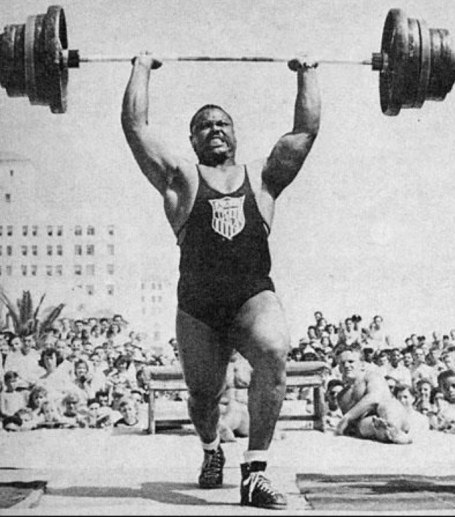Olympic weightlifting has no place for anyone not involved in the sport.

Olympic lifts and their variations include the snatch, jerk, clean and jerk, clean and press, high pull, and power clean. It also includes many assistance lifts such as front squats and overhead presses.
You should train to get stronger as safely as you can and then practice your sport if you need to develop speed. Olympic lifting fails to develop strength and speed as well as the alternatives.
Olympic weightlifting influenced resistance training during the early stages of its mainstream adoption. Their coaches and athletes appeared to know best about heavy training, making them the top gurus for an emerging field. Their influence still continues today and has led to bad practices such as periodization and other complicated yet poor ideas.
The Olympic lifts are dangerous for these reasons.
Reasons to Avoid Olympic Lifting
Build strength in the best way possible… with little or absolutely no regard to how that strength is to be used; then learn to use that strength to your greatest advantage in the only way possible, by practice of the sport itself.
– Arthur Jones
- They require explosiveness that reduces safety and results.
Acceleration and deceleration of a heavy weight places very high forces on the muscles, bones, and connective tissue. This creates fluctuations without time to react. This can overload tissues and cause injury. The wrist, elbow, and shoulder are most vulnerable.
By their nature, the Olympic lifts must happen quickly. Safer exercises give you the option to move at whatever speed suits you best. The ideal speed is neither too slow nor too fast.
Slower contractions allow the best stimulus for more strength and size. The negative phase of any exercise, absent on most of the Olympic lifts, generates more tension as well.
The force-velocity relationship makes it clear that moving slowly and lowering loads generates tension best. Tension is the squeeze you feel when a muscle contracts and is the main stimulus for muscle growth.
- They encourage bad mechanics.
The initial pull of many Olympic lifts leads to hypertension of the spine. Any deviation from a neutral spine that represents good posture can harm your lower back. Good training should never require your joints to enter unusual positions.
Several lifts also require overhead movements. These cause shoulder impingement. They also allow for extreme internal and external rotation which further damages the shoulder.
They often require great flexibility. Both too much flexibility and not enough both can bring problems. Anything away from a moderate amount of flexibility can lead to joint problems.
- They are non-specific for athletes.
Strength training should be general. Only the strength gained from an exercise transfers to other movements. Power cleans only make you better at power cleans, not vertical jumping or sprinting.
Skills either have a positive, neutral, or negative transfer.
Positive transfer occurs when prior learning assists your skills. Negative transfer occurs when prior learning hampers your skills. Neutral transfer indicates no connection between past and new skills. Mimicking skills with weights can lead to negative transfer.
A baseball player that swings with a weighted bat changes their mechanics. The steps of the swing alter slightly and this can throw off coordination when returning to the real movement.
They should have developed their power instead by training the relevant muscles heavily and then just jumping and swinging at full speed. The time spent trying to imitate a specific skill in the weight room would have been better spent in practice.
Training with heavy weights builds up the exact fast-twitch muscle fibers most responsible for speed. Rate of force development increases with fast movements though, so you do need to practice your skill.
Explosiveness comes from practicing specific motions fast, not through Olympic lifting.
- They rely on too much skill.
Never combine a high skill component with heavy weights. Getting strong should rely on simple exercises to allow the greatest intensity.
Even the advanced weightlifters struggle with mastery. They devote years to training everyday and still get hurt.
The exercises remain dangerous no matter what rep range you use as well.
- Better options exist.
Olympic weightlifting overloads no specific muscles.
The lower body gets understimulated. Imagine, for example, someone performing a squat followed by a curl. The weight possible with the legs would far exceed what the arms could ever handle.
The Olympic lifts have the same issue. A squat, row, and bench press would develop each muscle used better than a power clean ever could.
Any heavy weight can build muscle somewhere though. There is no doubt that Olympic lifting can develop tremendous strength while improving power. Safer and more effective options exist though, so it makes little sense to accept the risks.
Remove the Olympic Lifts
Olympic weightlifters are powerful because they have the right genetics, train hard, practice long, and often take drugs that aid performance. The training itself has no unique benefits.
Avoid trying to mimic the training of the elite. Playing basketball fails to make you taller.
Experts that support these lifts will frequently mention the low injury rates in Olympic lifting. We will not hear much to the contrary though since the survivors continue. Those that hurt themselves fail to return, usually placing blame instead on themselves.
There seems little incentive for honest self-reporting. Chat with any doctor at a big hospital about the injuries they see from explosive lifting.
No compromise should take place here. Remove them. Work on speed, if needed, by practicing your sport.
Lift weights sensibly to get strong, muscular, and improve your potential for speed without the Olympic lifts.
